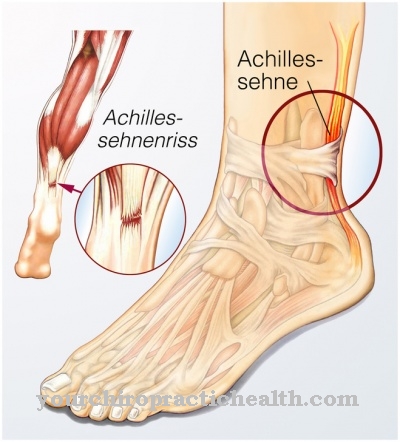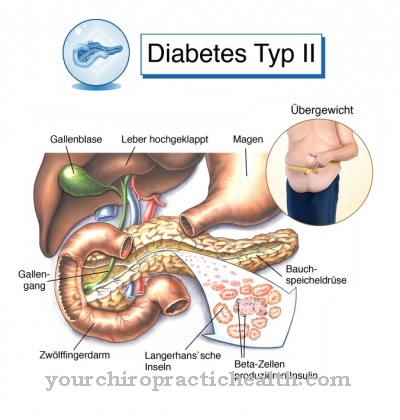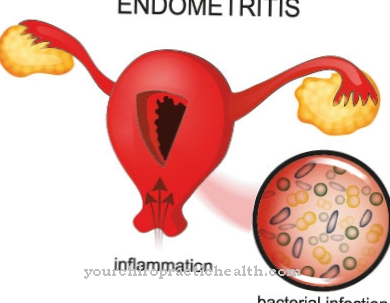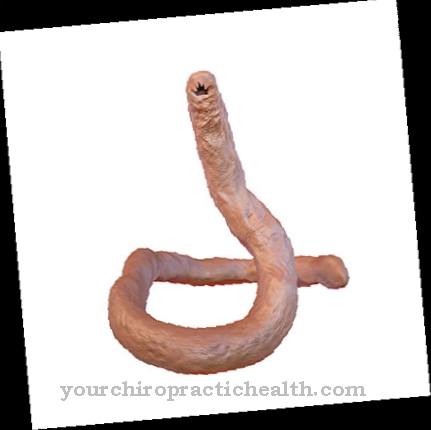If you get from a Achilles tendon tear or Achilles tendon rupture speaks, one means a complete severing of the Achilles tendon. This connects the calf muscle with the heel bone. The most common Achilles tendon tears occur during exercise, when the foot is jerked around or is otherwise heavily used. Severe pain and a loud, whip-like bang then indicate a ruptured Achilles tendon.
What is an Achilles tendon tear?

The Achilles tendon connects the heel bone with the calf muscles. As the strongest tendon in the human body, it is essential for walking and running.
It ensures that the heel can lift off the ground. If it is completely or partially severed, it is called an Achilles tendon tear or rupture.
This occurs suddenly and only rarely announces itself in advance through pain. In most patients it is covered, that is, without any external injuries.
A rupture of the Achilles tendon caused by external influences such as the action of glass or sharp-edged objects is possible, but less well known in practice.
causes
The Achilles tendon tear is a typical sports injury. Constant athletic and other stresses lead to signs of wear and tear, which then exceed the mechanical load-bearing capacity of the tendon tissue in the event of sudden tension or a kick.
Sports with a very rapid change of direction (for example handball or soccer) promote the frequency of the injury. Pre-existing conditions such as diabetes mellitus also reduce the ability to exercise stress. Men are more often affected by this injury than women.
The Achilles tendon tear is clearly audible and is accompanied by a bang (crack of a whip). Severe pain in the heel area follows. A dent is clearly palpable above the heel. If the Achilles tendon ruptures, the patient can no longer walk on tiptoe.
Symptoms, ailments & signs
An Achilles tendon tear is primarily associated with very severe pain. These usually occur directly on the tendon on the foot and can also radiate into the neighboring regions. This leads to very severe [foot pain, pain in the entire foot]] and usually also on the leg of the person affected.
Furthermore, the patients suffer from bleeding in the affected area and associated severe swelling. The pain also occurs at night due to the Achilles tendon torn, so that most patients also suffer from sleep problems or from depression and irritability. The quality of life is honestly restricted.
There are restrictions in movement and thus also severe restrictions in the everyday life of the person concerned. Ordinary movements are no longer possible for the person concerned. As a result of the Achilles tendon tear, the entire load-bearing capacity of the foot decreases, so that even strenuous activities can no longer be carried out without further ado.
It usually takes a few months for the foot to regain its capacity. A loss of strength can also occur through this crack. Due to the severe restrictions in everyday life, some people affected by the crack also suffer from psychological complaints or depression.
Diagnosis & course
Various methods are used for diagnosis. Usually the doctor will perform the Thompson calf compression test at the beginning. Furthermore, imaging methods such as ultrasound and X-rays are used.
The prognosis in the event of a ruptured Achilles tendon for complete restoration of the load-bearing capacity of the foot depends to a large extent on the treatment measures and the athletic demands of the patient.
A torn Achilles tendon that is not treated usually leads to a loss of strength. A regenerated tendon forms within two to four months, but it is not a full replacement for the Achilles tendon.
On the other hand, professional therapy and consistent follow-up treatment almost always lead to the restoration of the load-bearing capacity of the Achilles tendon. For competitive athletes, however, the prognosis can be far more negative and lead to the end of their careers.
A rupture of the Achilles tendon can be prevented by avoiding rapid, abrupt and extreme loads.
Complications
If an Achilles tendon tear is operated on, structures nearby can be injured. Bruising, bleeding, secondary bleeding and circulatory disorders can occur. If nerves are injured, sensory disorders and symptoms of paralysis can occur.
In addition, the anesthesia also carries a certain risk. It can also lead to wound healing disorders, wound infections, excessive scarring and infections. The tendon can shorten or lengthen. If a blood congestion cuff is used, pressure damage, for example paralysis, can be caused.
Swelling that lasts for a long time may occur after the operation. The swelling can cause problems during subsequent therapy - for example when adjusting the shoes. Sensitivity disorders can occur in the area of the surgical scar.
A bandage is usually applied when the Achilles tendon ruptures. The pressure in the bandage can damage blood vessels and nerves. Muscles and bones can weaken from the restricted movement. Sudeck syndrome can also occur. The bone is severely broken down and a painful inflammation results. Blood clots can also form. In addition, allergic reactions with varying degrees of severity can occur.
A torn Achilles tendon increases the risk of leg vein thrombosis. In addition, it can lead to a new crack, a so-called re-Reptur. Overall, the function of the Achilles tendon can be restricted after a tear.
When should you go to the doctor?
A ruptured Achilles tendon should receive medical attention as soon as possible. A visit to the doctor is recommended even if a serious injury to the Achilles tendon is suspected. Anyone who suddenly feels severe pain in the tendon area while exercising, which may be associated with a whip-like noise, should see a doctor immediately. This is particularly advisable if the symptoms persist or intensify quickly after exercise.
If the foot can no longer be unrolled as before, there may be a tear in the Achilles tendon that must be treated. Restrictions in the movement of the toes (the foot can no longer "bend down") also indicate an injury that requires treatment.
In general, complaints in the area of the calves or heels that persist after the usual regeneration phase must be medically clarified and, if necessary, treated. In the case of acute pain, first aid measures in the form of cooling compresses and rest should be taken. If there is severe pain or paralysis in the foot, an ambulance service should be called in.
Doctors & therapists in your area
Treatment & Therapy
First of all, it is important to take the right immediate measures in the event of a ruptured Achilles tendon. The foot must be relieved, cooled, bandaged and raised.
Depending on the patient's personal factors, the doctor can then decide between conservative and surgical therapy. Even if you decide to have an operation in most cases, you will resort to the non-surgical method of treatment if certain conditions are met. Age, smoking, possible arterial circulatory disorders or the use of certain medications are particularly risk factors.
A firm bandage (bandage, plaster cast, orthosis) initially immobilizes the injured foot in the tip foot position for about a week. This is followed by a special shoe with a removable heel raised for a period of about 6 weeks.
During an operation, the two ends of the Achilles tendon are put back together. The suture can be reinforced by the muscular skin of neighboring muscles. The operation is followed by physiotherapeutic measures to restore mobility as quickly as possible.
Here, too, a special shoe is used to gradually increase the load on the Achilles tendon. Longer immobilization of the lower leg is not recommended in the event of a ruptured Achilles tendon.
Outlook & forecast
In most cases, an Achilles tendon tear can be treated surgically. Depending on the time of the intervention and the patient's constitution, the tendon can usually be restored to its original range of motion. However, as a result of an operation, redness and itching, as well as thickened areas and scars, can remain, which can lead to movement disorders. In spite of successful therapy, some patients complain of swelling, pain or a lower load capacity of the affected leg.
Rarely, infections, circulatory disorders or shortening of the tendon can also occur. With newly healed tears, there is a risk that the tendon will tear again and require further treatment. In general, several months of follow-up treatment is necessary for a ruptured Achilles tendon. After three to four months, the injury should be healed and the person affected can be active again. Competitive training should be restarted at least six months after a tendon rupture. Otherwise, there may be another crack and the development of chronic complaints.
The risk of further injuries and chronic pain exists especially in older patients who have already suffered a tear in the Achilles tendon. If there is another disease of the tendons, joints or muscles, this can also affect the prognosis.
Aftercare
A torn Achilles tendon is treated surgically in order to restore the functionality of the calf muscles and thus restore normal walking. Follow-up care by the patient and the doctor is important in order to optimize regeneration. Physiotherapists are also involved in the aftercare process.
Essentially, it is about allowing the sutured Achilles tendon to heal completely so that it can function properly again. For this it is important that the tissue is not overused for a period specified by the doctor. Athletes in particular, who understandably would like to start training again, shouldn't put too much strain on the Achilles tendon too soon.
Light doses at the beginning of the training are just as important as breaks to regenerate between units. Consistent pre-stretching is just as important as post-stretching after exercise. Both should be performed gently and should not cause pain. Special focus should be placed on the calf muscles, which exert direct tension on the Achilles tendon and must therefore not be shortened.
The footwear is an essential factor in the follow-up care for a ruptured Achilles tendon. Because high heels promote cramping of the muscles of the calf and thus indirectly put a lot of strain on the Achilles tendon. Flat shoes are much cheaper in this context, as is walking barefoot.
You can do that yourself
As with most acute sports injuries, if you tear your Achilles tendon, there are good ways to help yourself. Doctors recommend the PECH rule to patients, which is also used in first aid. Even sprains and fractures can be optimally cared for on their own.
The individual letters of the acronym stand for pause, ice, compression and elevation. In detail, this means: raise the injured part of the body, protect it and, in the best case, no longer move it. Furthermore, the affected area must be cooled. You can do this with either an ice pack or a piece of cloth soaked in cold water. Behind the point Compression is the instruction to connect the injury. The reason for this is not only to stabilize the affected area, but also to prevent too much blood or secretion from leaking into the surrounding tissue. In principle, however, the bandage must not be placed too tightly, otherwise there is a risk of aggravation. The last important step is elevation. The injured limb should be propped up on a pillow or chair - as a rule of thumb, medical professionals advise that it should be higher than the heart.
However, it is important that a doctor classifies the injury in order to rule out serious injuries before the patient begins his own measures.














.jpg)












